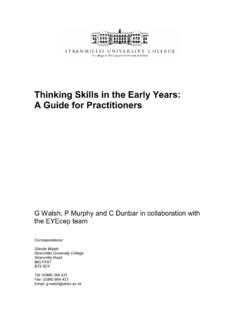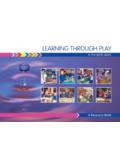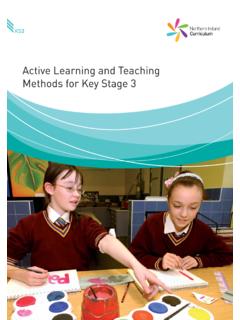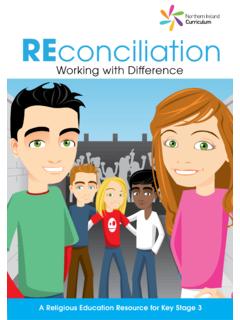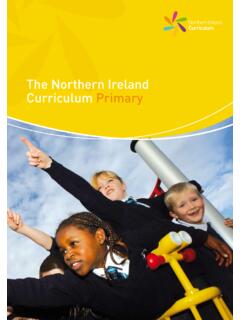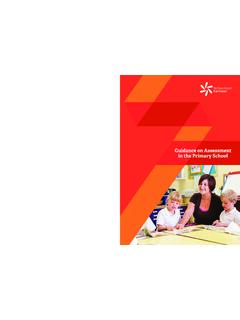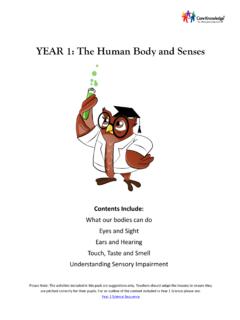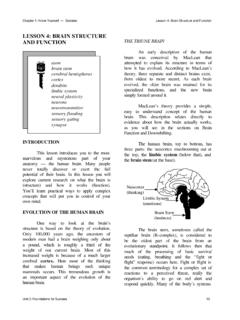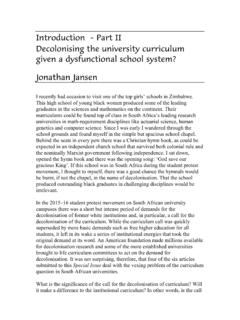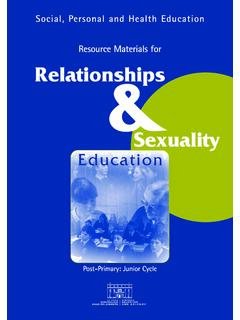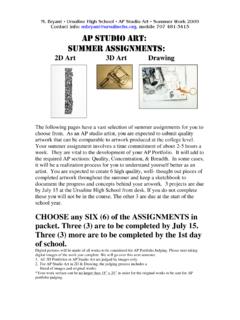Transcription of Take Care, Be Safe - Curriculum
1 The main themes of this unit are: - finding out about how to keep healthy; - being aware of the people, places and things that may put you at risk; and - developing greater responsibilities as you grow Development and Mutual Understanding: Key Stage 1, Year 3 Strand 1: Personal Understanding and HealthUnit 3: take care , be SafeComplementary Unit: Why Should I? take care , Be SafeTeaching approachesGreat OutdoorsTake the learning outdoors. Make opportunities for learning, creating and investigating. Make your own class vegetable plot. Grow onions, potatoes or carrots to use in a hearty stew at harvest time. Children will readily engage when they are able to grow, harvest and see their food being served. Invite a senior citizen from the local community to help you. Making a DifferenceTeachers can create conditions within the classroom that help children with their learning. However, they cannot do everything! A lot of learning takes place outside of school, both in the family structure and in the community.
2 Remember that you have limits. You can make a difference but you don t make all the difference. Similarly, you cannot do everything and need to stop thinking that this is what you are tasked to do. Remember there are limits: teachers can influence learning but not determine Out BoardDedicate an area of free space to a Finding Out Board. During themed learning, ask the children to record what they would like to find out about on post-it notes. Attach them to the relevant information on the Finding Out Board , for example, the titles of books, leaflets, and website addresses. Encourage the children to seek answers to their questions. Update the information on a regular basis. The Enterprise ApproachFollow the four R s when creating new ideas and turning them into a reality:Realising ideas: make the idea of growing things real for the children when they have a real audience and : encourage the children to work together to reach taking: encourage the children to enjoy the unexpected and the experience of not knowing the : give the children ownership of the project and encourage them to generate ideas and make and discuss the importance of keeping healthy and how to keep safe in familiar and unfamiliar environments:- being aware of how to care for their body in order to keep it healthy and well;- recognising and practicing basic hygiene skills; - realising that growth and change are part of the process of life and are unique to each individual;- exploring appropriate personal safety strategies; - beginning to realise the importance of road safety; - understanding that many substances can be dangerous.
3 And - knowing the safety rules that apply when taking on Foundation StageWorking at Key Stage 1 Strategies and skills for keeping themselves healthy and safe : - recognising and valuing the options for a healthy lifestyle, including the benefits of exercise, rest, healthy eating and hygiene;- being aware of the stages of human growth and development;- recognising how responsibilities and relationships change as people grow and develop;- understanding that medicines are given to make you feel better, but that some drugs are dangerous;- knowing what to do or whom to seek help from when feeling unsafe;- being aware of different forms of bullying and developing personal strategies to resist unwanted behaviour; - knowing about potential dangers and threats in the home and environment; and - developing simple safety rules and strategies to protect themselves from potentially dangerous Experiencesin developing strategies of keeping themselves healthy and safe Progress in learningI am beginning to predict and understand the consequences of some of my can describe and know why it is important to carry out basic hygiene can identify safe people in my community that I can ask for know what I could do if my personal safety was at know what I have to do to make the class/school a safe place for myself and can explain why there are rules for safety around am able to generate options and explain the consequences of each can identify, locate and select different sources of am beginning to know more about the process of growing from young to old and how peoples needs change.
4 I can tell you how my needs are changing as I grow am developing an awareness of and respect for other people s needs. I can describe how I could look after myself. I can describe a situation where I would need adult help. I am getting better at turn-taking and co-operating when working in a towards Key Stage 2 How to sustain their health, growth and well being and coping safely and efficiently with their environment:- understanding the benefits of a healthy lifestyle, including physical activity, healthy eating, rest and hygiene;- knowing about the harmful effects to themselves and others of tobacco, alcohol, solvents and other illicit and illegal substances;- knowing how the body grows and develops;- being aware of the physical and emotional changes that take place during puberty; - recognising how responsibilities change as they become older and more becoming aware of the potential danger of relationships with strangers or acquaintances, including good and bad touches;- developing a pro-active and responsible approach;- knowing where, when and how to seek help.
5 And- being aware of basic emergency procedures and first Stage 1, Year 3 Strand 1: Personal Understanding and HealthTake care , Be Safe2 Recognise and begin to appreciate a lifestyle that is both healthy and on what the focus is. In other words, what do you feel the children really need to know about being healthy and keeping safe . Make this central to your teaching and learning. Involve children in this planning process by, for example: - encouraging them to identify questions they want to explore and problems they want solved; - making a range of resources available to support their learning; and- identifying ways in which they can access information (for example, people, places and websites).Do Don t follow a rigid plan or sequence of activities. Instead develop, refine and re-invent what is to be learned and experienced depending on where the learning Learning togethertakes you and what works for you and the children in your class. - Prioritise a range of activities and share these with the children;- Share the overall learning Make sure to include opportunities to work individually, in pairs and in learning takes place when children are able to recall and re-tell what they have been learning, throughout the Discuss what they have been learning and ask them where they might use this.
6 - Encourage them to listen to each other and talk about how things were done. - Don t forget to challenge their intention:3 Managing informationAsk more focused questions about the task; clarify purpose and what needs to be done;Recognise where similar tasks have been done in the past;Use their own and others ideas to identify, locate and select various sources of information;Set goals for their work, break tasks into smaller parts and plan their next steps;Record information in a variety of formats; andBegin to identify audience and purpose when , problem solvingand decision-makingShow their ability to organise and summarise to show understanding;Sequence, order and rank information along different dimensions;Identify similarities and differences by making simple comparisons and connections;Begin to test predictions and to look for evidence;Make decisions and generate options;Decide what needs to be done in a group and take responsibility for aspects of the work;Show the ability to learn from shared and modelled activities.
7 Adapt behaviour and language to suit different situations;Show fairness to others; andRecognise and respect other people s feelings and that they are achieving their purpose by talking about what they are learning, how the work was carried out and some aspect that might be improved;Check work routinely for accuracy and precision;Persist with tasks until an appropriate endpoint, with teacher prompting;Seek help from other people; Work towards personal targets identified by teacher; and Develop an awareness of what they enjoy, what they find difficult, their personal strengths and possible solutions to problems;Be systematic and work through the stages in a task;Explain their methods and opinions, and the reasons for choices and actions; and Recognise the differences between why, what, where, when and how questions. Being creativeShow curiosity when approaching new tasks and challenges;Have experiences with all the senses;Listen to and share ideas and experiences;Generate as many ideas as possible, building and combining ideas; take time to use the imagination.
8 Enjoy the unexpected, unusual and surprising; and Experiment and investigate real life with othersDevelop further habits of collaborative learning;Become more adept at turn-taking, sharing and co-operating when working in a group or team;Thinking Skills and Personal Capabilities by the end of Key Stage 1 Using Skills and Personal CapabilitiesUsing MathematicsCreate graphs of real and relevant information that the children have collated. Growing means changing. Have the children create a graph that shows the number of missing teeth. The children experience growing together while learning about food and the local community. Words and phrases I will hear and use Well-beingTake a riskSafetyUnsafeDare, dangerSaferGrowing up Changing4 Across the Curriculum : Connecting the learningActivity 3 Green fingered entrepreneurs Taking an enterprise approach to growing 4 Risks Emphasising the importance of personal 5 People, places and things Children discuss the safe use of medical 1 Healthy choices Understanding healthy and not so healthy 2 Healthy gums and teeth Recognising the importance of good oral health and general 6 Rules about medicines Knowing the rules about the uses and sale of 7I grow and change Focusing on the range of life changes during their 8 Growing means changing Recognising that our responsibility for self increases as we grow activitiesPlanning and ideas Feeling goodDevelopingMedicines, pills and tabletsResponsibilityResearchChoiceFact.
9 OpinionRolesHealthy and unhealthyProtectionAdvertising5 SUGGESTED SUCCESS CRITERIAWe will explore what makes us healthy or will identify the choices we make and how they impact on our CONCEPTC hildren need to know the many factors that contribute to a healthy lifestyle. This will help them recognise that some of the choices they make may impact on their health and YOU NEED- Letter to Parent(s)/Carer(s) (Resource A)- Survey (Resource B)- Blank pages- ICT graphing softwareWHAT TO DO- Draw And Write- Healthy Day- SurveyGive two blank pages to each child. On one page have them draw a picture of what they think a healthy person looks like. Ask them to add some words and phrases to describe things the person might do to stay healthy. Next, ask the children to use their other page and to draw a person who is not so healthy. Again, encourage them to add words and phrases to describe things the person might or might not do. Draw And Write POINTS TO NOTEB efore starting this unit, send Resource A: Letter to Parent(s)/Carer(s) to all parents.
10 This will inform them of the activities that will take place and give them ideas of what they could do at home to support their child s learning in this area of the Curriculum .* The Draw and Write method has been adapted from Noreen Whetton, Health for Life. Learning activity 1: Healthy choices6 When the children have completed their drawings, invite them to bring their pictures together into an open space (either floor or table) and have a gallery session. First look at all the pictures of healthy people. As a class, discuss any similarities in the pictures, for example references to exercise, rest taken, diet (food and drink), personal hygiene, playing and friends. Encourage the children to think more deeply about all of the aspects of keeping healthy. Talk about the words or slogans that the children may have included on their pictures. Agree on the main characteristics of a healthy person. Collate these responses (perhaps as a pictogram) so that you have a record of what the class perceive to be healthy person.
